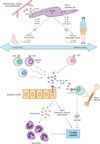IL-17-Mediated Immunity to the Opportunistic Fungal Pathogen Candida albicans
- PMID: 26188072
- PMCID: PMC4507294
- DOI: 10.4049/jimmunol.1500909
IL-17-Mediated Immunity to the Opportunistic Fungal Pathogen Candida albicans
Abstract
IL-17 (IL-17A) has emerged as a key mediator of protection against extracellular microbes, but this cytokine also drives pathology in various autoimmune diseases. Overwhelming data in both humans and mice reveal a clear and surprisingly specific role for IL-17 in protection against the fungus Candida albicans, a commensal microbe of the human oral cavity, gastrointestinal tract, and reproductive mucosa. The IL-17 pathway regulates antifungal immunity through upregulation of proinflammatory cytokines, including IL-6, neutrophil-recruiting chemokines (e.g., CXCL1 and CXCL5), and antimicrobial peptides (e.g., defensins), which act in concert to limit fungal overgrowth. This review focuses on diseases caused by C. albicans, the role of IL-17-mediated immunity in candidiasis, and the implications for clinical therapies for both autoimmune conditions and fungal infections.
Copyright © 2015 by The American Association of Immunologists, Inc.
Figures

Similar articles
-
CARD9+ microglia promote antifungal immunity via IL-1β- and CXCL1-mediated neutrophil recruitment.Nat Immunol. 2019 May;20(5):559-570. doi: 10.1038/s41590-019-0377-2. Epub 2019 Apr 17. Nat Immunol. 2019. PMID: 30996332 Free PMC article.
-
Role of neutrophils in IL-17-dependent immunity to mucosal candidiasis.J Immunol. 2014 Feb 15;192(4):1745-52. doi: 10.4049/jimmunol.1302265. Epub 2014 Jan 17. J Immunol. 2014. PMID: 24442441 Free PMC article.
-
CX3CR1 is dispensable for control of mucosal Candida albicans infections in mice and humans.Infect Immun. 2015 Mar;83(3):958-65. doi: 10.1128/IAI.02604-14. Epub 2014 Dec 29. Infect Immun. 2015. PMID: 25547797 Free PMC article.
-
Skin Immunity to Candida albicans.Trends Immunol. 2016 Jul;37(7):440-450. doi: 10.1016/j.it.2016.04.007. Epub 2016 May 10. Trends Immunol. 2016. PMID: 27178391 Free PMC article. Review.
-
Recent advances in the IL-17 cytokine family.Curr Opin Immunol. 2011 Oct;23(5):613-9. doi: 10.1016/j.coi.2011.07.006. Epub 2011 Aug 16. Curr Opin Immunol. 2011. PMID: 21852080 Free PMC article. Review.
Cited by
-
Protective effects of arecanut seed phenols in retinoic acid induced osteoporosis and the potential mechanisms explored by network pharmacology.Front Endocrinol (Lausanne). 2024 Oct 10;15:1472146. doi: 10.3389/fendo.2024.1472146. eCollection 2024. Front Endocrinol (Lausanne). 2024. PMID: 39449745 Free PMC article.
-
Host-microbe interaction paradigms in acute and recurrent vulvovaginal candidiasis.Cell Host Microbe. 2024 Oct 9;32(10):1654-1667. doi: 10.1016/j.chom.2024.08.018. Cell Host Microbe. 2024. PMID: 39389030 Review.
-
Retrospective identification of the first cord blood-transplanted severe aplastic anemia in a STAT1-associated chronic mucocutaneous candidiasis family: case report, review of literature and pathophysiologic background.Front Immunol. 2024 Jul 24;15:1430938. doi: 10.3389/fimmu.2024.1430938. eCollection 2024. Front Immunol. 2024. PMID: 39114664 Free PMC article. Review.
-
Controlling Candida: immune regulation of commensal fungi in the gut.Infect Immun. 2024 Sep 10;92(9):e0051623. doi: 10.1128/iai.00516-23. Epub 2024 Apr 22. Infect Immun. 2024. PMID: 38647290 Free PMC article. Review.
-
Microbiome: Role in Inflammatory Skin Diseases.J Inflamm Res. 2024 Feb 15;17:1057-1082. doi: 10.2147/JIR.S441100. eCollection 2024. J Inflamm Res. 2024. PMID: 38375021 Free PMC article. Review.
References
-
- Romani L. Immunity to fungal infections. Nat Rev Immunol. 2011;11:275–288. - PubMed
-
- Dongari-Bagtoglou A, Fidel P. The host cytokine responses and protective immunity in oropharyngeal candidiasis. J Dent Res. 2005;84:966–977. - PubMed
-
- Brown GD, Denning DW, Gow NA, Levitz SM, Netea MG, White TC. Hidden killers: human fungal infections. Sci Transl Med. 2012;4:165rv113. - PubMed
-
- Jacobsen ID, Wilson D, Wachtler B, Brunke S, Naglik JR, Hube B. Candida albicans dimorphism as a therapeutic target. Exp Rev Anti-Infect Ther. 2012;10:85–93. - PubMed
Publication types
MeSH terms
Substances
Grants and funding
LinkOut - more resources
Full Text Sources
Other Literature Sources
Medical

